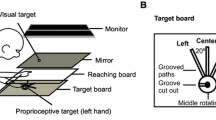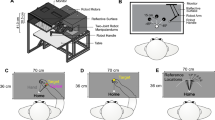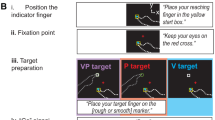Abstract
Reaching with visual feedback that is misaligned with respect to the actual hand’s location leads to changes in reach trajectories (i.e., visuomotor adaptation). Previous studies have also demonstrated that when training to reach with misaligned visual feedback of the hand, the opposite hand also partially adapts, providing evidence of intermanual transfer. Moreover, our laboratory has shown that visuomotor adaptation to a misaligned hand cursor, either translated or rotated relative to the hand, also leads to changes in felt hand position (what we call proprioceptive recalibration), such that subjects’ estimate of felt hand position relative to both visual and non-visual reference markers (e.g., body midline) shifts in the direction of the visuomotor distortion. In the present study, we first determined the extent that motor adaptation to a translated cursor leads to transfer to the opposite hand, and whether this transfer differs across the dominant and non-dominant hands. Second, we looked to establish whether changes in hand proprioception that occur with the trained hand following adaptation also transfer to the untrained hand. We found intermanual motor transfer to the left untrained (non-dominant) hand after subjects trained their right (dominant) hand to reach with translated visual feedback of their hand. Motor transfer from the left trained to the right untrained hand was not observed. Despite finding changes in felt hand position in both trained hands, we did not find similar evidence of proprioceptive recalibration in the right or left untrained hands. Taken together, our results suggest that unlike visuomotor adaptation, proprioceptive recalibration does not transfer between hands and is specific only to the arm exposed to the distortion.





Similar content being viewed by others
References
Abeele S, Bock O (2003) Transfer of sensorimotor adaptation between different movement categories. Exp Brain Res 148:128–132
Balitsky Thompson AK, Henriques DY (2010) Visuomotor adaptation and intermanual transfer under different viewing conditions. Exp Brain Res 202:543–552
Butler AJ, Fink GR, Dohle C et al (2004) Neural mechanisms underlying reaching for remembered targets cued kinesthetically or visually in left or right hemispace. Hum Brain Mapp 21:165–177
Carson RG, Elliott D, Goodman D, Dickinson J (1990) Manual asymmetries in the reproduction of a 3-dimensional spatial location. Neuropsychologia 28:99–103
Chang EC, Flanagan JR, Goodale MA (2008) The intermanual transfer of anticipatory force control in precision grip lifting is not influenced by the perception of weight. Exp Brain Res 185:319–329
Corbetta M, Miezin FM, Shulman GL, Petersen SE (1993) A PET study of visuospatial attention. J Neurosci 13:1202–1226
Cressman EK, Henriques DY (2009) Sensory recalibration of hand position following visuomotor adaptation. J Neurophysiol 102:3505–3518
Cressman EK, Henriques DY (2010) Reach adaptation and proprioceptive recalibration following exposure to misaligned sensory input. J Neurophysiol 103:1888–1895
Cressman EK, Henriques DY (2011) Motor adaptation and proprioceptive recalibration. Prog Brain Res 191:91–99
Cressman EK, Salomonczyk D, Henriques DY (2010) Visuomotor adaptation and proprioceptive recalibration in older adults. Exp Brain Res 205:533–544
Criscimagna-Hemminger SE, Bastian AJ, Shadmehr R (2003) Size of error affects cerebellar contributions to motor learning. J Neurophysiol 103:2275–2284
Dionne JK, Henriques DY (2008) Interpreting ambiguous visual information in motor learning. J Vis 8(2):1–10
Dizio P, Lackner JR (1995) Motor adaptation to Coriolis force perturbations of reaching movements: endpoint but not trajectory adaptation transfers to the nonexposed arm. J Neurophysiol 74:1787–1792
Farne A, Roy AC, Paulignan Y, Rode G, Rossetti Y, Boisson D, Jeannerod M (2003) Visuo-motor control of the ipsilateral hand: evidence from right brain-damaged patients. Neuropsychologia 41:739–757
Ghahramani Z, Wolpert DM, Jordan MI (1996) Generalization to local remappings of the visuomotor coordinate transformation. J Neurosci 16:7085–7096
Goble DJ, Brown SH (2008) Upper limb asymmetries in the matching of proprioceptive versus visual targets. J Neurophysiol 99:3063–3074
Hamilton CR, Bossom J (1964) Decay of prism aftereffects. J Exp Psychol 67:148–150
Henriques DY, Soechting JF (2003) Bias and sensitivity in the haptic perception of geometry. Exp Brain Res 150:95–108
Jones SA, Cressman EK, Henriques DY (2010) Proprioceptive localization of the left and right hands. Exp Brain Res 204:373–383
Jones SA, Fiehler K, Henriques DY (2012) A task-dependent effect of memory and hand-target on proprioceptive localization. Neuropsychologia 50:1462–1470. doi:10.1016/j.neuropsychologia.2012.02.031
Krakauer JW, Ghilardi MF, Ghez C (1999) Independent learning of internal models for kinematic and dynamic control of reaching. Nat Neurosci 2:1026–1031
Krakauer JW, Pine ZM, Ghilardi MF, Ghez C (2000) Learning of visuomotor transformations for vectorial planning of reaching trajectories. J Neurosci 20:8916–8924
Ostry DJ, Darainy M, Mattar AA, Wong J, Gribble PL (2010) Somatosensory plasticity and motor learning. J Neurosci 30:5384–5393
Redding GM, Wallace B (2008) Intermanual transfer of prism adaptation. J Mot Behav 40:246–262
Sainburg RL, Wang J (2002) Interlimb transfer of visuomotor rotations: independence of direction and final position information. Exp Brain Res 145:437–447
Salomonczyk D, Cressman EK, Henriques DY (2010) Intermanual transfer of visuomotor adaptation without sensory recalibration. In: Annual meeting for the Canadian society for psychomotor learning and sport psychology, Ottawa, ON
Salomonczyk D, Cressman EK, Henriques DY (2011) Proprioceptive recalibration following prolonged training and increasing distortions in visuomotor adaptation. Neuropsychologia 49:3053–3062
Salomonczyk D, Henriques DY, Cressman EK (2012) Proprioceptive recalibration in the right and left hands following abrupt visuomotor adaptation. Exp Brain Res 217:187–196. doi:10.1007/s00221-011-2985-4
Simani MC, McGuire LM, Sabes PN (2007) Visual-shift adaptation is composed of separable sensory and task-dependent effects. J Neurophysiol 98:2827–2841
Thut G, Cook ND, Regard M, Leenders KL, Halsband U, Landis T (1996) Intermanual transfer of proximal and distal motor engrams in humans. Exp Brain Res 108:321–327
Treutwein B (1995) Adaptive psychophysical procedures. Vision Res 35:2503–2522
Vetter P, Goodbody SJ, Wolpert DM (1999) Evidence for an eye-centered spherical representation of the visuomotor map. J Neurophysiol 81:935–939
Wang J, Sainburg RL (2003) Mechanisms underlying interlimb transfer of visuomotor rotations. Exp Brain Res 149:520–526
Wang J, Sainburg RL (2004) Interlimb transfer of novel inertial dynamics is asymmetrical. J Neurophysiol 92:349–360
Wang J, Sainburg RL (2006) Interlimb transfer of visuomotor rotations depends on handedness. Exp Brain Res 175:223–230
Wang J, Sainburg RL (2007) The dominant and nondominant arms are specialized for stabilizing different features of task performance. Exp Brain Res 178:565–570
Wang J, Przybyla A, Wuebbenhorst K, Haaland KY, Sainburg RL (2011) Aging reduces asymmetries in interlimb transfer of visuomotor adaptation. Exp Brain Res 210:283–290
Acknowledgments
We would like to thank Rozbeh Kamran-Disfani for help with data collection. This work was supported by the Natural Sciences and Engineering Research Council (NSERC). Ahmed A. Mostafa is supported by the Egyptian Ministry of Higher Education and Research (MOHE).
Author information
Authors and Affiliations
Corresponding author
Rights and permissions
About this article
Cite this article
Mostafa, A.A., Salomonczyk, D., Cressman, E.K. et al. Intermanual transfer and proprioceptive recalibration following training with translated visual feedback of the hand. Exp Brain Res 232, 1639–1651 (2014). https://doi.org/10.1007/s00221-014-3833-0
Received:
Accepted:
Published:
Issue Date:
DOI: https://doi.org/10.1007/s00221-014-3833-0




